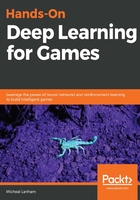
Deep Learning for Games
Welcome to Hands-on Deep Learning for Games. This book is for anyone wanting an extremely practical approach to the complexity of deep learning (DL) for games. Importantly, the concepts discussed in this book aren't solely limited to games. Much of what we'll learn here will easily carry over to other applications/simulations.
Reinforcement learning (RL), which will be a core element we talk about in later chapters, is quickly becoming the dominant machine learning (ML) technology. It has been applied to everything from server optimization to predicting customer activity for retail markets. Our journey in this book will primarily be focused on game development, and our goal will be to build a working adventure game. Keep in the back of your mind how the same principles you discover in this book could be applied to other problems, such as simulations, robotics, and lots more.
In this chapter, we are going to start from the very basics of neural networks and deep learning. We will discuss the background of neural networks, working our way toward building a neural network that can play a simple text game. Specifically, this chapter will cover the following topics:
- The past, present, and future of DL
- Neural networks – the foundation
- Multilayer perceptron in TensorFlow (TF)
- Understanding TensorFlow
- Training neural networks with backpropagation
- Building an Autoencoder in Keras
You might be inclined to skip this chapter if you've already grasped deep learning. Regardless, this chapter is well worth reading and will establish the terminology we use throughout the book. At the very least, do the hands-on exercise—you will thank yourself later!